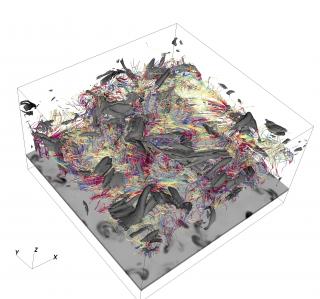General
The research that is being carried out by the group can be condensed into two main lines:
1) Study of the structure, dynamics, physical conditions and chemical evolution of Galactic and extragalactic ionized nebulae through detailed analysis and modelization of their spectra. Investigation of chemical composition gradients along the disk of our Galaxy and in nearby galaxies.
2) Determine the physical-chemical conditions of galactic planetary nebulae with bipolar geometry and nebulae around symbiotic stars. The aim is to understand the origin of bipolarity and to test theoretical models that attempt to explain nebular morphology and kinematics, with special emphasis on models with central binary stars. We will also study the implications of the evolution of binary systems in other astrophysical scenarios, such as the formation of jets, cataclysmic variables, and nova and supernova-type explosions.
Members
Results
- Using EMIR/GTC spectra in the near infrared range, tellurium and bromine emission lines have been detected for the first time in two planetary nebulae. These heavy element detections in one of their places where they are formed, give us information about the abundance patterns of heavy elements owing to the r-process and the s-process.
![Izquierda - Imagen RGB de la nebulosa de Orión y M43 obtenida filtros estrechos con la cámara WFC en el INT: H alfa (rojo), [S II] 6716+30 (verde), [O III] 5007 (azul). Derecha - Imagen en falso color de la nebulosa planetaria NGC 6778. En azul se ve la emisión en la línea de O II tomada con el filtro sintonizable azul del instrumento OSIRIS en el GTC; en verde imagen con el filtro estrecho de [O III] del Nordic Optical Telescope (NOT). Izquierda - Imagen RGB de la nebulosa de Orión y M43 obtenida filtros estrechos con la cámara WFC en el INT: H alfa (rojo), [S II] 6716+30 (verde), [O III] 5007 (azul). Derecha - Imagen en falso color de la nebulosa planetaria NGC 6778. En azul se ve la emisión en la línea de O II tomada con el filtro sintonizable azul del instrumento OSIRIS en el GTC; en verde imagen con el filtro estrecho de [O III] del Nordic Optical Telescope (NOT).](/sites/default/files/styles/crop_rectangle_21x9_to_1280/public/images/project/imagen_web.jpg?itok=_CZ-LRtm)


